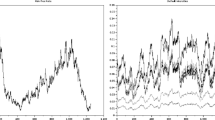Summary
Based on the models of Hull & White (1990) for the pricing of non-defaultable bonds and Schmid & Zagst (2000) for the pricing of defaultable bonds we develop a framework for the optimal allocation of assets out of a universe of sovereign bonds with different time to maturity and quality of the issuer. We estimate the model parameters by applying Kaiman filtering methods as described in (Schmid & Kalemanova 2002). Based on these estimates we simulate the prices for a given set of bonds for a future time horizon. For each future time step and for each given portfolio composition these scenarios yield distributions of future cash flows and portfolio values. We show how the portfolio composition can be optimized by maximizing the expected final value or return of the portfolio under given constraints.




Similar content being viewed by others
Notes
0Based on an earlier version printed in the Algo Research Quarterly, Vol. 5, No.l, Rudi Zagst, Jan Kehrbaum and Bernd Schmid, “Portfolio Optimization under Credit Risk”, pp. 23–41, Copyright 2002, Algorithmes Publications. Website: www.algorithmics.com.
1Most of the previous empirical studies use weekly or monthly data. Besides Duellmann and Windfuhr (Duellmann & Windfuhr 2000) we are the only ones to use daily data — at least up to our knowledge.
2If we are given a benchmark return b (t) for the period [0, t], the corresponding absolute benchmark B (t) to be compared with the simulated portfolio values Vk (φ, t) is given by
$$B{(t)}=V{(\varphi,\text{?}0)}\cdot{(1+b{(t)})}.$$
References
Bawa, V. (1975), ‘Optimal rules for ordering uncertain prospects’, J, Finan. Econom. 2, 95–121.
Dembo, R. (1993), Scenario immunization, in S. Zenios, ed., ‘Financial Optimization’, Cambridge University Press.
Duellmann, K. & Windfuhr, M. (2000), ‘Credit spreads between german and italian sovereign bonds — do affine models work?’, Working Paper.
Elton, E. & Gruber, M. (1991), Modern Portfolio Theory and Investment Analysis, John Wiley & Sons.
Harlow, W. (1991), ‘Asset allocation in a downside-risk framework’, Finan. Analysts J. 47(5), 28–40.
Harlow, W. & Rao, K. (1989), ‘Asset pricing in a generalized mean-lower partial moment framework: Theory and evidence’, J. Finan. Quant Anal. 24, 285–311.
Hull, J. & White, A. (1990), ‘Pricing interest rate derivative securities’, Rev. Fin. Stud. 3(4), 573–592.
Markowitz, H. (1952), ‘Portfolio selection’, J. Finance 7, 77–91.
Markowitz, H. (1991), Portfolio Selection, Blackwell.
Martin, J., Cox, S. & MacMinn, R. (1988), The Theory of Finance, Evidence and Applications, Dryden.
Mausser, H. & Rosen, D. (1999), ‘Efficient risk-return frontiers for credit risk’, Algo Research Quarterly 2(4), 35–48.
Nelson, C. & Siegel, A. (1987), ‘Parsimonious modeling of yield curves’, J. Business (60), 473–489.
Schmid, B. & Kalemanova, A. (2002), ‘Credit spreads between german and italian medium term zero coupon government bonds’., Research in International Business and Finance 16, 497–533.
Schmid, B. & Zagst, R. (2000), ‘A three-factor defaultable term-structure model’, J. Fixed Income 10(2), 63–79.
Sharpe, W. (1964), ‘Capital asset prices: A theory of market equilibrium under conditions of risk’, J. Finance 29, 425–442.
Zagst, R. (2002), Interest Rate Management, Springer.
Author information
Authors and Affiliations
Corresponding author
Rights and permissions
About this article
Cite this article
Zagst, R., Kehrbaum, J. & Schmid, B. Portfolio Optimization Under Credit Risk. Computational Statistics 18, 317–338 (2003). https://doi.org/10.1007/BF03354601
Published:
Issue Date:
DOI: https://doi.org/10.1007/BF03354601




